|
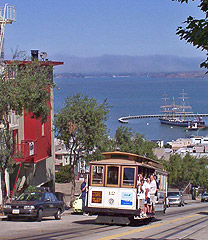
|
"Where little cable
cars, climb halfway to the stars" |
 . |
Behind the car is the power plant
for the cars which also contains a small, but free, museum. |
 |
Ride on the outside of the cars,
even if space is available inside. |
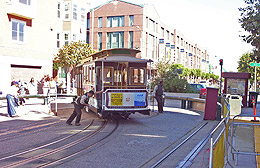 |
Turning them at the end of the run. |
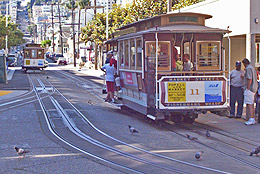 |
Ready to go for the next trip, while
another inbound car waits its turn to come forward to use the turntable. |
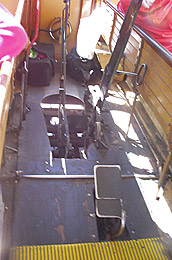 |
The 'cockpit' of the cars. No computers, all mechanical controls
(no hydraulics or electric motors).
The big lever in the middle of the hole grabs the cable, the lever
on the right and the foot pedal apply breaks. The long poker with
a loop handle that is stored against the right wall of the gripman's
work area is for snagging the cable and pulling it up into the jaws
of the grip.
|
|
Trundling along at a stately 9.5 mph, open to the
air, the cars are a wonderfully de-stressing trip. You are part of the
city you pass through, not isolated behind Plexiglas.
In the fall of 2004 I was in San Francisco on business
and had a chance to get reacquainted with the cable cars. On the first
trip I took, the 'gripman' was a Sikh. He kindly introduced all the tourists
to the customs of the car. He guided people to seats, encouraged the timid
to enjoy standing on the running board on the outside of the car and kept
the careless from getting hit by close encounters with cars. What a perfect
image of the America we all dream of: this man, bearded and turbaned,
from a very small minority population, enabling with quiet dignity the
white-bread Americans to experience a lost part of their own history.
At this point in the essay, I fully expected to have
to write a paragraph about how, of course, the cars are archaic and inefficient,
but efficiency isn't everything. However, a visit to the museum revealed
that each line is propelled by a single 500hp electric motor. Not bad
for moving several cars and a two-mile long cable. Especially when you
realize that there is zero pollution from the cars themselves. So maybe
there is something to be said for this mode after all. I suspect that
electric trolleys are still more efficient, but compared to a fleet of
diesel busses, the cars look pretty good.
Combine that with the conductors who will take your
picture, the car I rode with a scrawled note that "H. Bogart rode
this car, ca. 1946-47 'Dark Passage'" (which was shot in SF), a small
but free museum and all the Victorian era mechanical engineering you could
want.
That, and the most important fact of all: that one
can journey and arrive feeling better than when you started, a feat not
capable of being performed on the highway or in the packed airliners we
assume are the height of progress.
You travel close enough to outdoor restaurants to
almost touch the guests. And the unique and diverse architecture of San Fran houses is also brought before you as you glide along.
Many cities had cable cars including Seattle, Chicago
and Kansas City. San Francisco used to have many lines running all over
down town. But all that are left are four lines in San Francisco.
| A moment of quiet before the day gets going. |
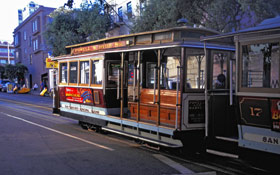 |
|